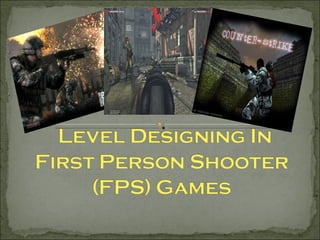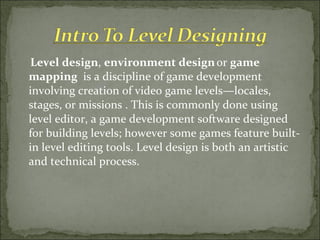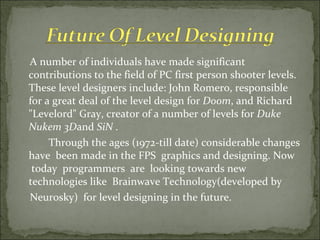Level Designing and Mapping
- 1. ?
- 2. By Ritam Chatterjee Rounak Haldar Computer Science & Engineering
- 3. Level design , environment design or game mapping is a discipline of game development involving creation of video game levelsĪ¬locales, stages, or missions . This is commonly done using level editor, a game development software designed for building levels; however some games feature built-in level editing tools. Level design is both an artistic and technical process.
- 4. First-person shooters are a type of 3D shooter game, featuring a first person point of view with which the player sees the action through the eyes of the player character. They are unlike Third person shooters which are seen from the back or side, allowing the gamer to see the character they are controlling. Some of the best & most played FPS games till date are Counter strike , Wolfenstien , Call of Duty series .
- 5. ?
- 6. Counter strike is greatest multiplayered FPS game till date. The map count ranges roughly over 100 with diverse level of terrains. Without any prior knowledge of designing a map can be created easily with the help of a software based designing tool.
- 7. ?
- 8. A wide variety of tools may be used by someone designing a level. Valve Hammer Editor , formerly known as Worldcraft and now commonly called Hammer , is Valve Software's map creation program for their game engine, Source. Most CS maps are designed in VALVE.
- 9. First the camera angle is set The block of desired length is placed on any 2d coordinate window Now as all the four windows are related to each other,changes in one affects all Textures is applied to the surface
- 10. Textured walls are erected on the edge of the base block Now the top is covered with same or different textured block to make the roof In outdoor maps the roofs can be textured to form the sky
- 11. ?
- 12. Things that can be added other than the bound walls fall under the category of Objects. Basically They are of 2types:- Internal Objects- computers, ladder , sofa, etc External Objects-chairs, tables, bench , etc
- 13. Before compilation the two most important points are to be added ,without which the game will not execute. They are:- Spawn points- from which characters emerge Way points-to which the play able characters need to reach for game continuity & completion
- 14. Valve Hammer Editor version 4.0 saves a level file in the .vmf format by default. Before this, it saved a level file in the binary, proprietary .rmf or text-based, human-readable .map format. The .vmf format is a simple file that contains all the information about a level. First, a level is passed through the bsp (Binary space partitioning) program. This program uses the brushes to create the architecture of the level. Second, the level passes through the vis (Visible Information Set) processor, which determines what polygons are rendered and what lights appear where. Finally, the level passes through the rad program. This program computes the lighting of the map, including pseudo-radiosity for Source maps, resulting in more natural-looking lighting.
- 15. A number of individuals have made significant contributions to the field of PC first person shooter levels. These level designers include: John Romero, responsible for a great deal of the level design for Doom , and Richard "Levelord" Gray, creator of a number of levels for Duke Nukem 3D and SiN . Through the ages (1972-till date) considerable changes have been made in the FPS graphics and designing. Now today programmers are looking towards new technologies like Brainwave Technology(developed by Neurosky) for level designing in the future.
- 16. ?
- 17. ?

















